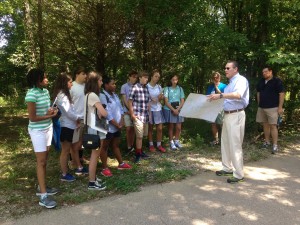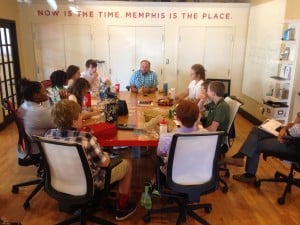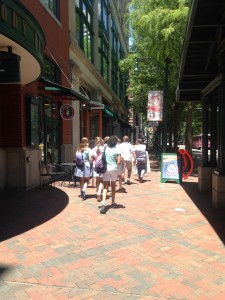Amplify Memphis Day One: Our environment, King Cotton, our future
“Excited.”
“Nervous.”
“Awkward.”
“Comfortable.”
Students summarized their feelings as they contemplated the three week summer course ahead with each other, driving in the van to new places, new even to an all-native Memphian crew of students. This experience, I shared with them, would be something that they would always connect them with each other. When they see each other in the halls of St. George’s this fall, they will be able to give each otherthat knowing nod that can only be created through the kind of deep shared experience you have by being on a sports team together, or going on an overnight camping trip, or traveling together to another country.
Our first visit on this quintessential Memphis blue-sky day was with the Wolf River Conservancy (WRC), symbolic of the paramount importance our natural environment plays in the quality of life, and economic prosperity, in Memphis. The WRC was founded in the 1980’s in opposition to proposals for mines, timber projects, and home development along the Wolf River. Keith Cole,  Executive Director, and Cathy Justis, Director of Education, along with several interns, native Memphians home from college, shared maps of the watershed bringing home to us the Wolf River watershed’s multi-state reach. Students looked at an integrated map of the county, showing the locations of the current Greenway and Greenline, with dotted lines outlining future projects that will allow someone in Collierville to ride a bike or walk contiguously all the way to Mud Island at the Mississippi River, or vice-versa. Greenways are considered to be “linear parks,” in our case paralleling the flow of the river with walking and cycling paths alongside, with land preserved to share with native species of mammals, birds, amphibians, and reptiles. A group hike had Cathy pointing out places where past flooding had deposited sand and showed us how the “channelization” (straightening) of a river increases water speed and erosion, and leads to the loss of critical wetlands areas in the attempt to mitigate periodic upstream flooding. Some take-aways from our time with the WRC included their expression of the need to engage high school and college students with the mission of the organization. How could they catalyze the power and contributions of youth in Memphis to help young people connect more deeply to the region’s environmental resources to both enhance their own quality of life and continue on the mission of preservation for future generations?
Executive Director, and Cathy Justis, Director of Education, along with several interns, native Memphians home from college, shared maps of the watershed bringing home to us the Wolf River watershed’s multi-state reach. Students looked at an integrated map of the county, showing the locations of the current Greenway and Greenline, with dotted lines outlining future projects that will allow someone in Collierville to ride a bike or walk contiguously all the way to Mud Island at the Mississippi River, or vice-versa. Greenways are considered to be “linear parks,” in our case paralleling the flow of the river with walking and cycling paths alongside, with land preserved to share with native species of mammals, birds, amphibians, and reptiles. A group hike had Cathy pointing out places where past flooding had deposited sand and showed us how the “channelization” (straightening) of a river increases water speed and erosion, and leads to the loss of critical wetlands areas in the attempt to mitigate periodic upstream flooding. Some take-aways from our time with the WRC included their expression of the need to engage high school and college students with the mission of the organization. How could they catalyze the power and contributions of youth in Memphis to help young people connect more deeply to the region’s environmental resources to both enhance their own quality of life and continue on the mission of preservation for future generations?
We headed next to Peabody Place to the headquarters of City Leadership, an organization whose mission is to recruit talent, develop leadership, and catalyze organizations to advance our city. The brain-child of John Carroll, Executive Director, City Leadership’s successes since its founding in 2010 include key consulting, brand development, social media strategy, talent acquisition, and website builds for o rganizations all around the region, whether they are for-profit or for-purpose. During a lunch conversation, we got to hear from John about his reflections about growing up in Tennessee and his journey to find his own purpose through following his acute interest in leadership. Students were struck by the viral spread of Choose901, a City Leadership program to bring millenial talent to Memphis through sharing the opportunities in a life of PURPOSE and ENJOYMENT here in Memphis. Choose901 has become “THE social media tag” for things we all love about our city and has taken on a life of its own, certainly underscoring how gratifying life in Memphis can be to people who are considering a move to Memphis. John talked about reconceptualizing the idea of “stress” as something to choose, rather than something to avoid. He believes that stress can be a means to increase one’s capacity to be able to better lead within an organization and contribute in leadership to make the world a better place. Stress is something to seek, rather than something we should seek to avoid if we want to be able to make an impact or make a real difference. The students were struck by his characterization of two types of people: those who consume and critique and those who instead create and cultivate. He asked them which one they wanted to be and invited them to be the latter…today. In reality, people can often underestimate what teenagers can do and don’t do enough to invite them to participate to authentic real-world problem-solving. At. St. George’s, one of our differences includes the fact that we are asking, even requiring, that our students grapple together and with us about real-world problems whose solutions could make the world an even better place.
rganizations all around the region, whether they are for-profit or for-purpose. During a lunch conversation, we got to hear from John about his reflections about growing up in Tennessee and his journey to find his own purpose through following his acute interest in leadership. Students were struck by the viral spread of Choose901, a City Leadership program to bring millenial talent to Memphis through sharing the opportunities in a life of PURPOSE and ENJOYMENT here in Memphis. Choose901 has become “THE social media tag” for things we all love about our city and has taken on a life of its own, certainly underscoring how gratifying life in Memphis can be to people who are considering a move to Memphis. John talked about reconceptualizing the idea of “stress” as something to choose, rather than something to avoid. He believes that stress can be a means to increase one’s capacity to be able to better lead within an organization and contribute in leadership to make the world a better place. Stress is something to seek, rather than something we should seek to avoid if we want to be able to make an impact or make a real difference. The students were struck by his characterization of two types of people: those who consume and critique and those who instead create and cultivate. He asked them which one they wanted to be and invited them to be the latter…today. In reality, people can often underestimate what teenagers can do and don’t do enough to invite them to participate to authentic real-world problem-solving. At. St. George’s, one of our differences includes the fact that we are asking, even requiring, that our students grapple together and with us about real-world problems whose solutions could make the world an even better place.
Walking down a bright and sunny North Main Street, with people enjoying time on the patios of Aldo’s, Oshi Burger, and Local, my mind wandered to the future when over 1200 employees of ServiceMaster would be filling the neighborhood during  their lunch hours and how that would continue to transform the area. The previous week’s announcement about the company’s move is widely considered to be a game-changer downtown and perhaps the happy and friendly attitudes of the professionals walking the street were an indication of the recognition of that fact, given that it was in fact a Monday. Preserved as almost a snapshot from the past is the Cotton Museum, with exhibits sharing cotton’s critical importance to our way of life, literally and figuratively here in Memphis. The museum does a great job in demonstrating facets of one of our essential questions, what has been the relationship between prosperity and hardship here in Memphis, and students listened to video accounts from farmers, balers, and traders about the cotton trade through their eyes, experience, and perspectives. After our time in the Cotton Museum, we retired to the rooftop of the Peabody Hotel, taking in the views and settling on the Thursday night party stage in the shade for some reflection on the day. Several questions emerged to carry with us:
their lunch hours and how that would continue to transform the area. The previous week’s announcement about the company’s move is widely considered to be a game-changer downtown and perhaps the happy and friendly attitudes of the professionals walking the street were an indication of the recognition of that fact, given that it was in fact a Monday. Preserved as almost a snapshot from the past is the Cotton Museum, with exhibits sharing cotton’s critical importance to our way of life, literally and figuratively here in Memphis. The museum does a great job in demonstrating facets of one of our essential questions, what has been the relationship between prosperity and hardship here in Memphis, and students listened to video accounts from farmers, balers, and traders about the cotton trade through their eyes, experience, and perspectives. After our time in the Cotton Museum, we retired to the rooftop of the Peabody Hotel, taking in the views and settling on the Thursday night party stage in the shade for some reflection on the day. Several questions emerged to carry with us:
- Where does City Leadership and Choose901 see themselves in ten years?
- How could information technology improve the living conditions of people in Memphis?
- How does cotton continue to influence the economic prosperity in Memphis and what is its legacy overall?
For the first day, our students certainly took in a great deal as we invited them into the complexity of the questions we are considering as a society and as a region. We’re excited about the road to come! Eleven students, one van, and twenty-six more for-purpose visits to go.